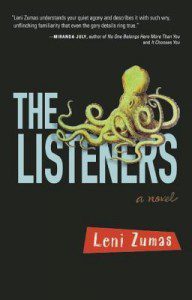
Reading Leni Zumas’s debut novel The Listeners puts one in mind of the Boston Molasses Disaster of 1919. Not because the novel is messy—it isn’t—but because it contains the same rare combination of death, absurdity, and beauty, and a tempo slow enough to allow the reader full appreciation of all three. And, like the Molasses Disaster—which occurred when a holding tank containing over two million gallons of molasses burst, sending sticky tidal waves into the streets and killing twenty-one bystanders in a neighborhood where natives still claim you can smell molasses on warm days—The Listeners will linger with readers for a long time after they have finished their journey through its pages. Zumas—whose first book, a story collection titled Farewell Navigator, was published in 2008—allows the reader to parse not just the story she sets forth in this novel, but to see the world in a new light as well. Perhaps most impressively, The Listeners imparts on us a new vocabulary with which to describe the experience of loss, grief, renewal, and the simple experience of everyday life.
At bottom, the story Zumas tells in The Listeners is a simple one: a family of five loses its middle daughter to a random act of violence, and twenty years later her survivors still do not understand what to do with their grief. The eldest daughter, Quinn, serves as the novel’s narrator, and in a disjointed chronology shares with the reader the story of her previous success as a musician and her slow descent into inertia. The book is divided into over 150 sections, some five pages long, some fewer than fifty words. In spite of the potential for disorganization this method imposes, the novel instead reads like an impeccably curated collection of shorts: many of them equally successful as individual pieces, but all contributing to a coherent whole. Entering the novel is like pulling a section of comb from a beehive, admiring the intricate labor that has formed each cell, and then taking equal pleasure in the sumptuousness of its contents.
The Listeners is, above all, a joy to consume, and Zumas forces even the most goal-oriented of readers to linger over its verbal felicities. Quinn, meeting a young fan on the bus, describes him as “a calamity-haired baby spark.” Watching commuters listening to music on their earbuds, she tells us that “the white-vein people sucked brain juice into their pockets, rushing.” Some passages cause in the reader a Joycean sense of defamiliarization, as when one reads that “Mink wiped the zinc and chewed a lime, worrying its pulp for last juices.” Others encourage a new attentiveness to one’s surroundings, as when Quinn begins a section by stating that “snow improved my ragged neighborhood: the scrawny trees went gentle against the falling white, and each fingerwise housefront appeared to be a holder of secrets.” It is this attraction to the overlooked and the odd—and, most crucially, to the truth that often lurks behind pat cliché—that allows Zumas to write with such understated grace about the most tragic circumstances. Narrating her sister’s death, Quinn tells the reader that “when the medics turned her over, brains and fat in a lace of red globbed onto the pillow. Her brain had many things in it: the length of a giant squid, the way to the library, the story of Lacustrina who lived in a lake and had a silver heart no boy could break.”
It is in part due to this style of writing that The Listeners succeeds in making the sister—referred to for the most part simply as “the middle”—as real to the reader as she is to her grieving family. Obsessed with feeling and knowing everything around her, she sands away the skin of her fingertips, copying the technique of safecrackers, who must “sense the teeny grooves of locks.” She is, in Quinn’s words, “extratalented in the odor department,” able to “smell on a book the reaction of the last person to read it. Crouched on the library carpet, she put her nose to the open Bible page: The woman was worried about not being good enough.”
In the hands of a lesser writer these character details could seem precious or contrived, but Zumas shows Quinn’s irritation with her sister as adeptly as she conveys her enchantment with her, and rarely have the homely and heartbreaking details of sisterhood been more arrestingly conveyed. The sisters’ shared synesthesia resists tweeness because it is also the topic of fights and confusion, and a sense of alienation for Quinn that only melts away when it signals her link with her sister. It is these details of life together and life apart that makes The Listeners stand out as an arresting journey down a well-trod path.
The questions that The Listeners poses—how did the sister die? Who is the dungeoner? What, exactly, was the accident that caused Quinn’s band break up?—are intriguing, but they do not dominate the reader’s experience of the novel. Zumas’ writing is not meant to be consumed in haste, but rather to encourage in the reader the same sense of intensified awareness we find in the sister. Relating the circumstances of their childhood, Quinn describes “wishing we had video games like regular families, or a TV at least. Lack of TV stuck you in rooms with lame sisters who wrapped themselves in sheets, pirouetting, singing ‘Where am I? Where am I? Where am I?’” Upon reaching the end of The Listeners, however—which makes the everyday world seem foreign and the mysterious familiar—the reader may be struck by an impulse to do just the same.




